7 Incredible Experiences in Cambodia’s Wild East
Hike, kayak and bike through Cambodia’s remote, wild east and discover some of the Kingdom’s most spectacular landscapes and its elusive wildlife, from elephants to endangered river dolphins, gibbons and beautiful birds of paradise.
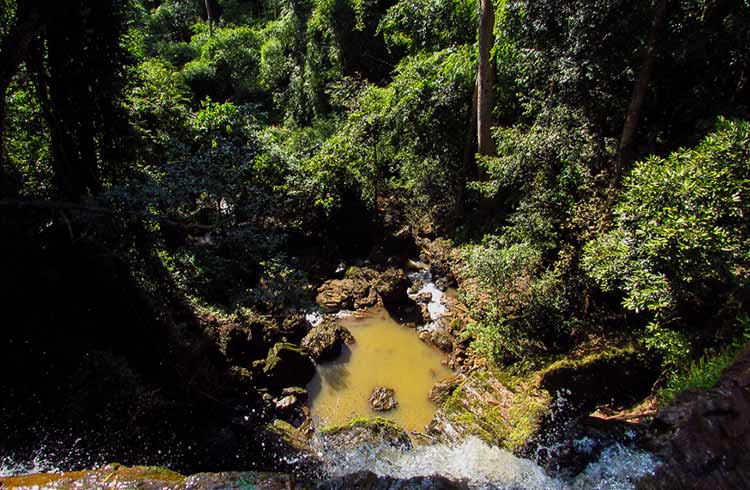 Photo © Cassie Wilkins
Photo © Cassie Wilkins
Cambodia’s wild east conjures up images of undiscovered temples, hill tribes, turquoise lakes in ancient volcanic craters, cascading waterfalls and flooded forests. Here’s how you can see and do it all.
- Kampong Cham
- Kratie
- Mondulkiri and Sen Monorom
- Ban Lung and Ratanakiri
- Virachey National Park and Hill Tribe Villages
- Stung Treng
- Preah Rumkoul
Kampong Cham
Your first stop on the drive northeast from Phnom Penh is the sleepy riverside city of Kampong Cham. Home of the famed Bamboo Bridge, which is rebuilt annually to link the city to the small Mekong River island of Koh Paen, Kampong Cham isn’t high on the list for most visitors to the Kingdom, but there are plenty of interesting places to visit.
Top of the itinerary is Wat Nokor, an Angkor-era temple set among rice paddies, and Phnom Pros and Phnom Srey (Man Temple and Woman Temple). A short drive from the city, the site features several intricate pagodas built on adjacent hills and offers good vantage points of the surrounding countryside. During the Khmer Rouge era, the valley between the hills was used as a place of torture, and now there is a small shrine to all the lives that were lost.
Nearby, there is also an old American ATC tower and runway that was used during the Vietnam War. These days, the site is quite underwhelming, but history buffs might enjoy it. Back in the city, the famous Kizuna Bridge was the first to span the Mekong. Prior to its opening in 2001, ferries and rafts were the only way to traverse east and west and cross the country.
Crossing the bridge to Tbong Khmum feels like taking a step back in time. Adventurous souls will get a kick out of the rickety ladders and great vistas from the top of the 19th-century French Tower, while others might just want to explore the local stilted Cham Muslim villages, with their traditional wooden houses and unusual-looking mosques.
The best way to cram everything in is by hiring a Tuk Tuk or renting a scooter or bicycle for the day. There are plenty of accommodation and restaurant options available in the town itself, but check out the guesthouses on the riverbank for spectacular sunrise views.
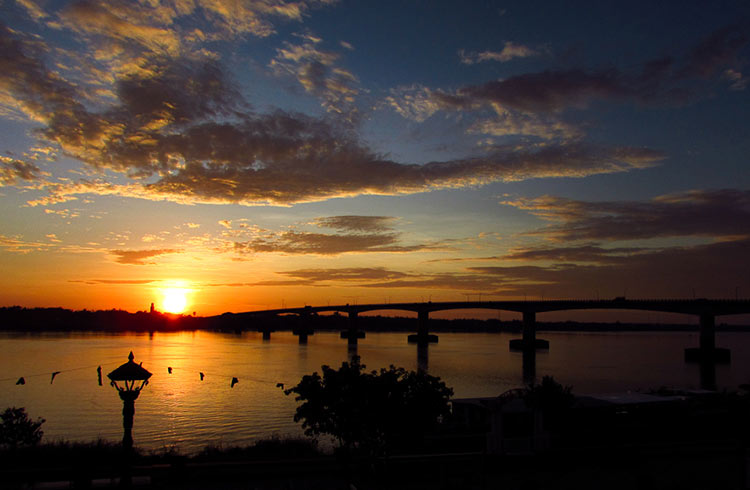
Kratie
Following the
Historically, Kratie’s most popular activity was dolphin-spotting on the Mekong from Kampi, a few miles north, these days the Irrawaddy dolphins are so elusive that it can be hit or miss. Once common across Asia, these blunt-headed unusual-looking dolphins are closely related to the killer whale. They live on the Mekong between Cambodia and Laos, where legend goes that they are reincarnations of their ancestors. However, with the rise of fishing in the region, especially using explosives, and a conflict of opinion between Vietnamese and Khmer fishermen who believe the dolphin to be sacred and the Khmer-Islam fishermen who see them as food, there has been a huge decrease in their population.
If you don’t feel like taking the gamble, there are plenty of other activities around Kratie. You can rent bicycles and go exploring the nearby countryside and head out to Phnom Sombok, a modern pagoda 6mi (10km) north of the city, worth visiting for its colorful paintings depicting what happens to those who choose not to live a virtuous life.
Alternatively, you can hop on a boat to the nearby Koh Trong Island and rent a bicycle. Check out the Vietnamese Wat and the floating village before heading to the beach for sunset views and a swim – for those brave enough to embrace the murky waters of the Mekong! Tour companies also offer overnight kayaking trips up the river.
There are plenty of transport and accommodation options in the city and around the riverbank. Tourist buses are available to destinations all over Cambodia and even Laos.
Mondulkiri and Sen Monorom
A few hours east of Kampong Cham lies Mondulkiri, one of Cambodia’s most untouched and beautiful regions. This wild province is as famous for its rolling hills dotted with pine forests, waterfalls, tribal villages, and lush jungle as it is for its sustainable elephant sanctuaries. Here you can learn all about these remarkable creatures and the wonderful work that local groups, like the Mondulkiri Project and the Elephant Valley Project, are doing to help care for injured animals and rehabilitate and retire working elephants in their natural habitat.
While Mondulkiri is perfect for lovers of hiking, coffee, nature, and wildlife, including several species of endangered primates like the black-shanked doucs, thrill-seekers can also go on multi-day treks and camp out in the jungle, go wild swimming, and even zip line over one of Cambodia’s most spectacular waterfalls, the double-tiered Bousra.
A variety of accommodation options can be found in the capital, Sen Monorom, which is about a five-hour drive from Phnom Penh. From Sen Monorom, it’s a beautiful drive to Ratanakiri up the old ‘Death Highway’, which is now fully paved (and far less deadly). It takes three-and-a-half to four hours to drive by minibus, but you can also hire a motorbike or a bicycle if you want to take your time exploring these beautiful off-the-grid regions.
Ban Lung and Ratanakiri
In the far northeastern reaches of Cambodia lies the remote Ratanakiri province, with vibrant green hills and plateaus, thick jungle, crater lakes, rivers, and mountains.
The capital of Ratanakiri, Banlung, is a small yet interesting city, with cool eateries and interesting accommodation, especially around the lake. These days the new highways have made transport links much easier, and you can now get from Banlung to the 4,000 Islands (in Laos) via Stung Treng, or even cross the local border into Vietnam, as long as you organize your visa in advance.
This far-away province is also the adventure hub of Cambodia, where you can go on rafting and camping trips, trek through jungle and lava forests, and visit remote waterfalls, gem-mining quarries, and off-the-grid coffee plantations. Just outside of Banlung, you can also visit the magical Yeak Loam crater lake and swim in the turquoise waters of a volcano that has been extinct for 700,000 years.
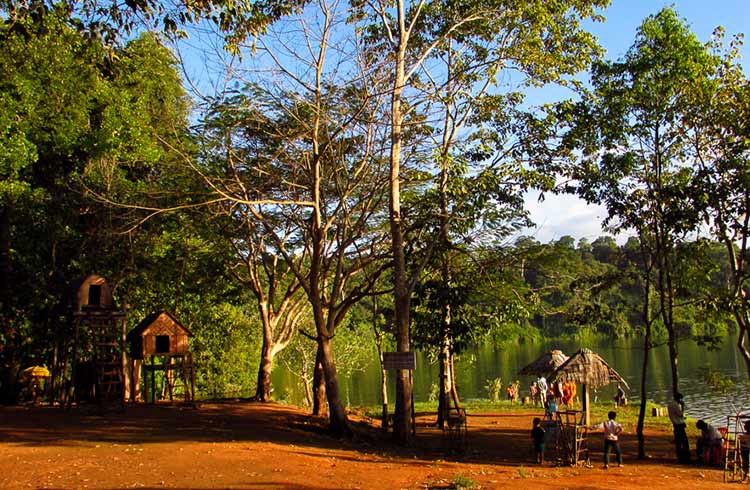
One of the most interesting things about Ratanakiri, however, is its tragic history, especially when it comes to its tribal villages and ethnic minorities. For more than 1,000 years, Ratanakiri has been home to the tribal Khmer Loeu people, who have long been persecuted, initially by being sold and traded as slaves to neighboring empires, and then as part of a forced ‘Khmerization’ campaign beginning in the ‘50s. Many traditional villages were destroyed when the area was heavily bombed by the US during the Vietnamese War.
During the civil war, the Khmer Rouge took control of the area and attempted to stamp out the traditions of the Khmer Loeu, forbidding them from speaking native languages or practicing their religious traditions. There were ethnic purges and many indigenous people were killed. In recent years, the opening up of the region has led to an influx of Khmers, increased land prices and political corruption which has threatened their way of life even more. These days, it feels like the young people in the villages are more interested in mobile phones and the outside world than continuing the traditions of their ancestors, leaving their future in jeopardy.
One of the ways the local communities are counteracting this is by working as tour guides, sharing their traditions and opening up their villages to sustainable tourism, including homestays and opportunities to view their unique way of life.
Virachey National Park and hill tribe villages
Despite the challenges facing them, Ratanakiri is still home to 12 of the kingdom’s most unique ethnic minority groups, most of whom still live like they always have, in remote semi-nomadic tribal villages around the forests of Virachey National Park. One of the Kingdom’s premier wildlife spotting destinations, the 1,283mi² (3,325 km²) national park is also the home of the incredibly rare northern yellow-cheeked gibbon.
Whether you do a short tour to the tribal villages or a multi-day tour into the depths of the beautiful Virachey National Park, book your trip with a local organization and ensure the profits go to those who need them. The tribal village tours are all led by indigenous guides to villages and fascinating forest cemeteries with elaborately carved memorials. They share with you their unique traditions and ways of life, that have barely changed over the last thousand years. Photographs are permitted, but ask first and be as respectful as possible.
Longer treks can also include nature walks through the jungle, bamboo river rafting and visiting hidden waterfalls deep in the Virachey National Park. Trips lasting from one to seven days can be easily organized in Banlung, including a guide, transport, food, accommodation, and fees to the national park and nature preserves.
Stung Treng
Historically, Stung Treng has been nothing more than a jump-off town on the way to Laos or Banlung, but these days it’s becoming an attraction, with a new bridge connecting it to western Cambodia, and community-focused eco-villages popping up along the banks of the river. Although the city itself is rather uninspiring, there is still a surprising amount to do, including kayaking through flooded forests, cycling through the countryside, and dolphin spotting on the border with Laos.
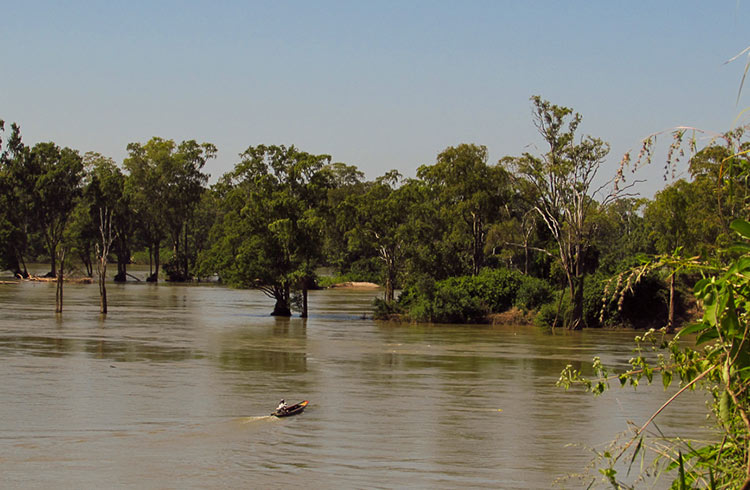
From Stung Treng, you can easily take a boat all the way up to the 4,000 Islands, where you can capture a glimpse of the mighty Sopheakmit Waterfall, and check out the remnants of the 19th-century French-built boat docking station. Here, boats were lifted onto train carriages to transport them across the islands, bypassing the waterfall, and continuing up the Mekong to China. From Stung Treng, you can also visit Thala Barivat, a pre-Angkorian site with ruins dating back to the 7th century.
Preah Rumkoul
About 37mi (60km) to the west of Stung Treng, Preah Rumkoul is an eco-tourism site on the southern border of Laos. To get here you can either take a Tuk Tuk to O’Svay and hire a shallow canoe to take you across the river past the flooded forests, or hire a bike or a moto-dop in Stung Treng and ride the 40-odd miles (60 km) around the river. The ride is one of the most beautiful in Cambodia, passing limestone karsts, fossilized trees, and isolated backwater villages.
Those who brave the journey will be rewarded with local homestays and family-cooked meals in a beautiful location, with birdwatching, swimming, cycling, and beautiful waterfalls. This is also one of the only spots in Cambodia where you can capture a glimpse of the river dolphin from the shore, with a specially built platform that is also perfect for drinking an ice cold beer and watching the days go by. From here, you can head back the way you came, and continue onto Laos, carry on toward Prasat Preah Vihear, or head down to Siem Reap.
Related articles
Simple and flexible travel insurance
You can buy at home or while traveling, and claim online from anywhere in the world. With 150+ adventure activities covered and 24/7 emergency assistance.
Get a quote
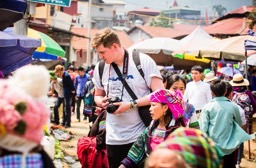
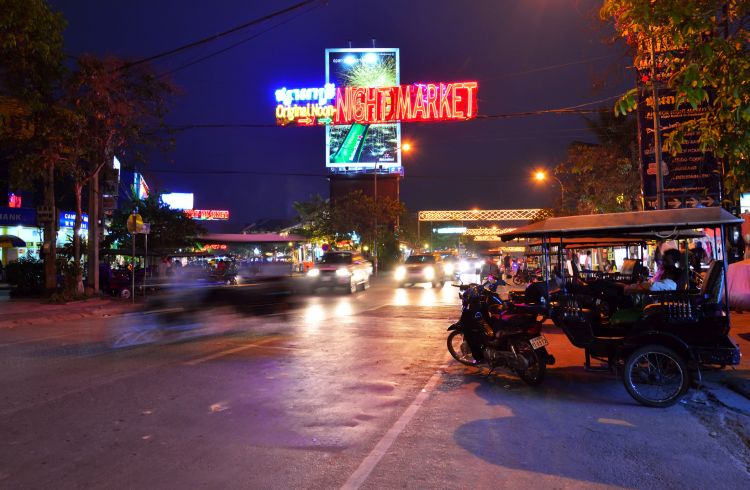
No Comments